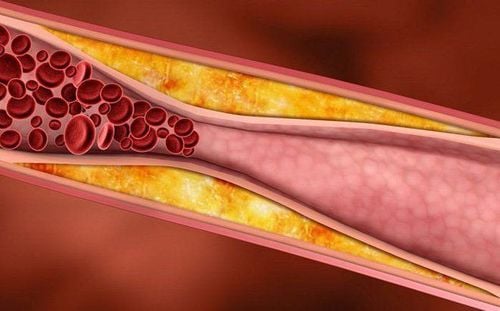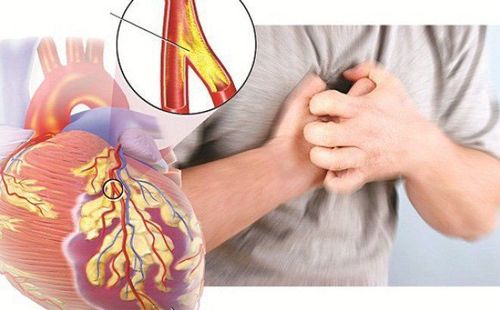This is an automatically translated article.
Article by Doctors Le Duc Hiep and Nguyen Xuan Thanh - Cardiology Center, Vinmec Times City International Hospital
Coronary heart disease is a common among heart diseases in developed countries. Usually the pathogenesis of coronary insufficiency is due to fat deposition in the subendothelial layer of coronary arteries. The gradual progression of atherosclerosis leads to the formation of a blood clot that causes an embolism in the blood vessel. The main complications of coronary artery disease are angina pectoris, myocardial infarction and can lead to sudden death.
1. Epidemiology of coronary heart disease
Includes angina and myocardial infarction in approximately 6% of men > 50 years of age. In Europe every year, about 0.3-0.6% of people get sick. In terms of mortality, each year accounts for about 120-250 deaths per 100,000 people in industrialized countries. This rate increases with age: 800-1000 deaths per 100,000 people aged 65-74 for men, 300/100,000 for women of the same age.In Vietnam, there is no population statistics, but statistics at major hospitals show that patients with coronary artery disease are usually at the age of 50 or older. However, nowadays there is a trend of rejuvenation, especially in cases under 30 years old.
2. Risk factors for coronary heart disease
2.1. Unmodifiable risk factors
Age The risk of cardiovascular events increases with age. Epidemiological studies show that age is one of the most important predictors of disease. You can't reduce your age, but eating right and staying active can help slow down the aging process. The risk of cardiovascular events increases with age.
Gender Men have a higher risk of coronary heart disease and stroke (about 70%) than women. However, after menopause, the rate of increase in cardiovascular diseases is as fast as that of men.
Genetic factors Research evidence shows that people with a genetic (familial) factor in cardiovascular disease or stroke have a higher risk of cardiovascular disease than others. Genetic factors also include race.
2.2. Modifiable risk factors
Hypertension Hypertension is the most common cardiovascular risk factor and also the most well-studied risk factor. Hypertension is considered a silent killer and is the strongest risk factor for cardiovascular events. High blood pressure often has no symptoms and causes a host of dangerous cardiovascular complications. Good treatment of high blood pressure significantly reduces cardiovascular risk.
Hypercholesterolemia Increased levels of lipids (fats) in the blood (cholesterol and triglycerides) are very common and are one of the most important modifiable risk factors for cardiovascular disease.
Smoking Cigarette smoking (including pipe tobacco) is a proven risk factor that increases the risk of coronary artery disease, stroke, and peripheral vascular disease. Besides, smoking also causes lung cancer and a host of other diseases. If you smoke, quit immediately, because quitting is a proven measure to reduce the risk of cardiovascular disease. Passive smoking (when you are exposed to secondhand smoke) is equally risky.
Overweight - Obesity To varying degrees all increase the risk of cardiovascular disease.
Diabetes and insulin resistance People with diabetes, especially type II diabetes, have a higher rate of coronary heart disease and stroke than the general population. Diabetes accelerates the process of atherosclerosis and its complications.
Inactivity (sedentary lifestyle) A sedentary lifestyle is considered a risk factor for cardiovascular risks. Regular daily exercise of at least 30 minutes has a significant benefit in reducing the risk of cardiovascular disease.
Alcohol consumption Currently, recommendations suggest that, if used in moderation, ie no more than one drink (equivalent to 1 can of 5% 330ml beer, or 50ml of 30% alcohol) per day, drink less does not pose a cardiovascular risk and can to some extent help prevent atherosclerosis and coronary artery disease. Drinking alcohol in moderation in large amounts has a risk of cardiovascular disease.

Có rất nhiều yếu tố nguy cơ có thể thay đổi được.
3. Causes of coronary heart disease
Caused by coronary artery damage: The main cause is coronary atherosclerosis. In addition, other causes are not due to atherosclerosis: coronary artery spasm, vasculitis (multiple nodular arteritis, lupus erythematosus, congenital abnormalities).Consequences of heart valve diseases: Aortic valve disease: stenosis, aortic regurgitation, syphilis. Consequences of cardiomyopathy. They are a group of possible causes of functional coronary insufficiency without coronary artery stenosis.
4. Pathogenic mechanism
Even at rest, the heart uses a large amount of oxygen taken from the coronary blood. During exertion, the heart must increase blood flow into the coronary arteries to deliver more oxygen to the heart muscle. Like other arteries, blood flow in the coronary arteries is influenced by two factors: perfusion pressure and vessel wall resistance.In normal people without coronary artery disease, because the arterial system is very developed, the resistance is very low, so the heart can withstand exertion, including anemia and attacks that lower blood pressure without causing heart failure. no myocardial damage.
Vascular resistance begins in the small coronary arteries. And blood flow is ensured by the great coronary arteries, which are large tubes that carry blood into the heart muscle. Atherosclerosis usually occurs in large coronary arteries and when the artery diameter narrows above 70%, blood flow will be severely reduced and small arteries must reduce resistance by continuously dilating. out to allow blood to pass through. If there is hypotension or there is agitation and exercise, the coronary arteries will not adapt in time. At that time, angina or myocardial infarction will appear. The above mechanism also explains why there is not a complete coronary artery occlusion, but there is a myocardial infarction.
5. Typical pain
The pain typically occurs with exertion, is emotional, and goes away a few minutes after cessation of exertion. It is the most clinically specific symptom. Characteristic of the pain: A angina-like pain, or a feeling of heaviness behind the breastbone, often spreading to the left arm. If doing the same movement as going up the stairs, the patient must stop on the step where the pain has occurred from previous times. If angina occurs on exertion, it is highly likely to be coronary, although the location of the pain may be atypical: Pain in the neck, back, shoulder, abdomen, left arm without pain in the chest, in posterior breast.In addition, there are a number of factors that can also cause coronary artery spasm causing chest pain such as when the temperature is cold or when the temperature changes rapidly from hot to cold. It also explains more frequent occurrence of chest pain or myocardial infarction in the cold season.

Cơn đau điển hình xuất hiện khi gắng sức, cảm xúc, và mất đi vài phút sau khi thôi gắng sức.
6. Clinical forms of angina
Stable angina :Stable angina usually occurs in a patient whose coronary system is already narrowed by atherosclerotic stenosis, but the plaque is stable and relatively stable. The degree of stenosis will be proportional to the exercise capacity. Stable angina manifests as pain that occurs during exertion or emotion and subsides 1-5 minutes after cessation of exertion or emotional stabilization.
Unstable angina
It is when the atherosclerotic plaque is unstable, can slough off and form a blood clot that partially or completely blocks the coronary artery that can progress to a heart attack. Chest pain manifests itself as more intense and sudden. It can appear during exertion or at rest, completely unpredictably.
7. Prevention of coronary heart disease
Improve risk factors:Change in nutrition: Limit foods high in fat, animal fat, limit alcohol, eat light food and eat more green vegetables and fruits. Have a regular exercise regimen of at least 2.5 hours/week with moderate intensity. Maintain a stable weight. Quit smoking completely. Well control hypertension, diabetes, dyslipidemia. When sick, need: coronary heart disease
Regular check-ups. Take the medicine regularly, at the right dose, at the right time of the day. When there are abnormal symptoms, go to the nearest medical facility for timely treatment. To protect cardiovascular health in general and detect early signs of coronary heart disease, customers can sign up for the Cardiovascular Screening Package of Vinmec International General Hospital. The examination package helps to detect cardiovascular problems at the earliest through tests and modern imaging methods. The package is for all ages, genders and is especially essential for people with risk factors for cardiovascular disease.
Why should you choose Cardiovascular Screening Package at Vinmec International General Hospital?
Simple and quick procedure. Enthusiastic advice and support, reasonable and convenient examination process. Comprehensive facilities, including a system of clinics and consultations, blood collection rooms, dining rooms, waiting areas for customers,... Highly qualified medical staff, Professional working style, dedicated and attentive.
Please dial HOTLINE for more information or register for an appointment HERE. Download MyVinmec app to make appointments faster and to manage your bookings easily.













